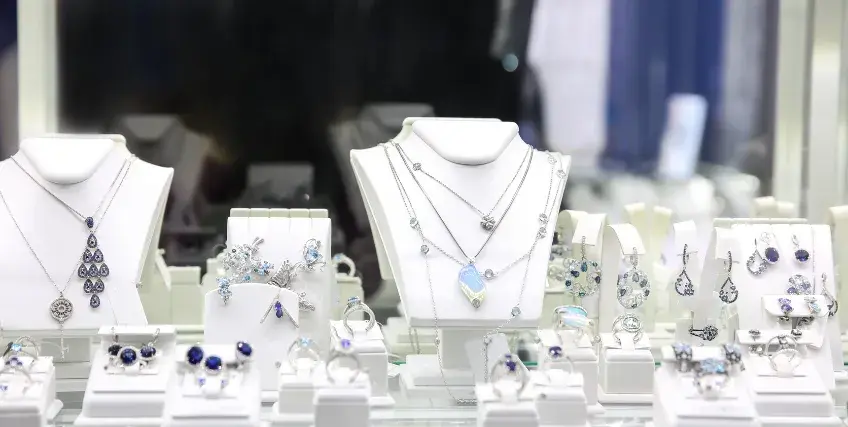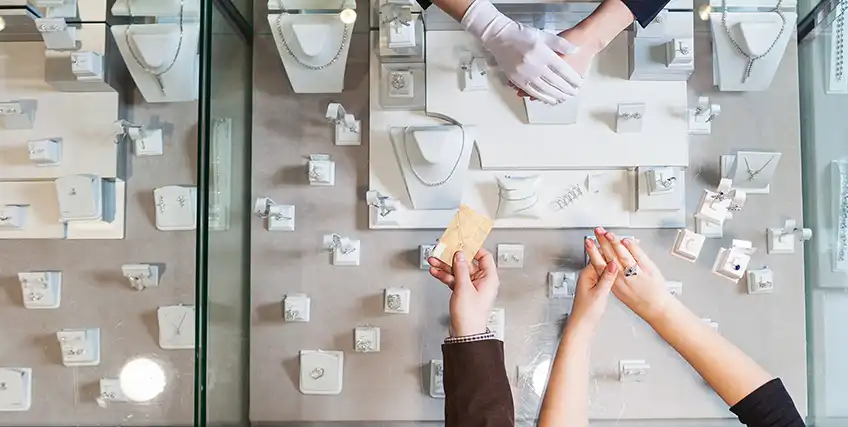How Tariffs, Trade Policy & Materials Costs Are Reshaping Jewelry Manufacturing for Small Businesses
October 08, 2025 | Last Updated on: October 08, 2025

Jewelry manufacturers for small businesses are at a crossroads in 2025, navigating a period of turbulence marked by tariffs, shifting trade policies, and soaring material costs.
For those determined to thrive, adaptation is essential. From international upheaval to local ingenuity, this in-depth exploration reveals how these forces are reshaping the industry and how smart strategies and creative financing can empower small jewelers to excel despite daunting headwinds.
This article will help you to understand the current situation of tariffs and trade policies, which are reshaping the industry of jewelry manufacturers for small businesses.
Tariffs: Redefining the Business Landscape
These abrupt policy changes have driven up the cost of raw materials and finished jewelry alike, making it increasingly difficult for local jewelers to maintain traditional product lines and price points. As tariffs permeate every link in the supply chain, their effect ripples through sourcing, manufacturing, and retailing, ultimately coming to rest squarely on the shop floor.
Jewelry manufacturers for small businesses face a threefold challenge. The necessity of passing on higher costs to customers threatens to compromise sales volume. As a result, many producers have sought out alternative sourcing such as smaller stones, less expensive metals, or laboratory-grown gems.
Others seek out local sources, but domestic production is often just as costly and tends to be restrictive in terms of variety. The result is a constant push and pull as producers balance quality jewelry, uniqueness, and affordability, demanding new levels of ingenuity and agility.
Global Sourcing Versus “Made in USA”
Historically, American retailers have relied on international suppliers to provide a variety of unique designs and economies of scale. Tariffs have increased the price of importing items for American jewelry stores, and jewelry manufacturers for small businesses are reevaluating long-standing relationships.
The growth and appeal of "made in USA" labels has not yet enabled complete divestiture from established foreign suppliers, particularly since limited supply, specialized labor, and price point concerns about out-of-pocket expenses often result in many small-to-medium-sized businesses not moving away from foreign suppliers.
Innovative jewelry manufacturers for small businesses are creatively negotiating with suppliers previously unapproachable and adopting a hybrid model that combines partially local and partially global supply chains to build market share and mitigate risk.
Trade Policy: Navigating Uncertainty
Trade policy forever changes. Redone transactions and surprise import bans have piled tariff pressures, confusing manufacturers' forecasts and jewelry business planning.
Jewelry manufacturers for small businesses are disproportionately hurt, lacking the cushion and clout of large chains. They must react quickly to revised rules, reswap deals, and often recreate their logistics.
The escalation of trade wars in 2025 has left jewelers jumping for alternatives and searching for seasoned, low-profile partners in emerging markets.
Materials Costs: Volatility Redefined
Precious metals and gems are at the heart of jewelry manufacturing, and their costs have increased significantly due to inflation, supply chain disruptions, and tariffs. Gold jewelry, for instance, has reached record highs, spurred not only by investor speculation but also by logistical jams.
Sterling silver, platinum, and palladium have followed suit, with producers lacking long-term pricing stability due to unpredictable market volatility. The ripple effect touches every sector of manufacturing. Polishing, setting, and custom design now command a premium as skilled labor becomes increasingly scarce and more sought after.
Gemstones, a business already sensitive to international politics, have become increasingly volatile, with natural stones being priced out of the budgets of small jewelry brands and synthetic stones ending up in new tariff categories. This puts continuous pressure on the profit margins of jewelry manufacturers for small businesses, demanding attention and active stock buying management.
Evolving Retail: Omnichannel as Survival
Jewelry manufacturers for small businesses must now offer seamless omnichannel integration of online and physical store experiences, updating inventory information in real-time, and converting new buyers across multiple platforms.
Such growth needs the adoption of technology, from using e-commerce giants like Shopify to experimenting with advanced CAD/CAM and 3D printing for designing and prototyping. Small plants are increasingly relying on ERP software to manage manufacturing, logistics, and sales from a single virtual platform, facilitating quick business management and improved profitability.
Labor Costs and Skill Scarcity
Each piece of fine jewelry is the result of certain skills, which have great value, but are now being called into question due to increased labor costs. The pool of skilled jewelers is shrinking, and experienced laborers are commanding higher pay as competition intensifies.
This leads small manufacturers to feel generally squeezed, requiring additional investment in labor retention and training just to maintain production at high-quality standards.
For some, it may require having closer relationships with loyal jewelry suppliers and focusing more on quality and efficiency rather than cost-effective products.
Sustainability and Traceability: A New Imperative
Transparency and sustainability are no longer options in 2025; they are requirements to address the demands of the next generation of consumers. Consumers who purchase jewelry demand visible, transparent supply chains, from ethically mined gems to ethically sourced metals.
Blockchain and Artificial Intelligence have made unprecedented visibility possible, and retailers who can't demonstrate an ethical promise are at risk of being shunned. Jewelry manufacturers for small businesses must adapt by investing in certifications and technology that track each step of the jewelry's journey.
As consumer activism expands, the lesson for small producers becomes increasingly clear: sustainable jewelry is a key competitiveness issue. Jewelry companies with ethics-driven sourcing not only attract younger consumers but also win price premiums even in volatile markets where price sensitivity tends to dominate purchasing decisions.
Creative Adaptation: Embracing Technology and Trends
Technology is transforming jewelry manufacturers for small businesses, turning problems into opportunities. 3D printing and CAD have significantly reduced prototyping time, enabling rapid design revisions through quick iterations and highly customized products for online stores and boutique retailers.
Advanced business management software helps manage workflow, making it easier for small jewelers to compete with significantly larger businesses in terms of efficiency, inventory control, and customer care.
Fashion trends, too, are evolving at a breakneck pace. Agility, both in manufacturing and in observing trends and managing inventory, is essential for adaptation. Small companies that closely monitor global fashion trends and quickly update their product lines tend to have better margins and greater brand loyalty, turning volatility into an opportunity.
Strategic Financing: The Backbone of Resilience
Finding an appropriate jewelry store with no interest financing is an option to surviving today's pressures. Modern lenders understand the unique risks associated with jewelry creation and offer new products tailored to the realities of jewelry manufacturers for small businesses. Inventory financing programs enable jewelers to buy materials and merchandise ahead of time, paying only as piece of jewelry is sold, easing cash flow pressures and reducing day-to-day risk.
Term loans with payoff incentives for early payoff offer boutiques and manufacturers flexibility, and asset-based For Jewelry manufacturers for small businesses, narrative is everything. Consumers are besieged from every direction by choices, with many opting for cheaper, replica jewelry online, but nothing replaces the emotional value and quality control of a well-crafted, custom piece. Small makers who invest in personalized branding, engraving, and custom finishes speak to their audiences on a more personal level, rendering their brand name equivalent to both aesthetic value and emotional value. Superb craftsmanship and low minimum order quantities allow boutiques to introduce cutting-edge new lines without exorbitant overhead. A focus on quality assurance, accommodation of changing tastes, and an emphasis on useful partnerships establish the jewelry manufacturers for small business niche in the field. Jewelry manufacturers for small businesses must navigate an astonishing number of challenges: seamless omnichannel experiences, supply chain efficiency, skills shortages, changing consumer behavior, and low-cost competition. Fortunately, the path forward is supported by technology, innovative jewelry store financing options, and standards of ethics and quality for products. Jewelry manufacturers for small businesses lead through advanced analytics, reducing costs by diversifying local and global supply chains, and personalizing every customer touchpoint. This approach enables effective risk management, fosters the acquisition of loyal customers, and promotes alignment with high standards of ethics and sustainability. Also Read: Merchant Cash Advances: Are They Right for Jewelry Businesses? In response to tariffs, unpredictable trade policies, and meteorically rising material and labor expenses, Jewelry manufacturers for small businesses are demonstrating how staying resilient can be profitable, with deliberate adjustments and shrewd use of financing and technology. The formula for success is investing in quality, personalization, ethical sourcing, omnichannel retailing, and good financial partners. As market disruptions persist, the successful jewelry designers for smaller firms will be those who see each challenge as a summons to reinvention. Their future lies in staying alert to new trends, embracing technology, and utilizing ethical storytelling, as well as innovative financing tools, all while preserving the craftsmanship and emotional intimacy of jewelry handcrafted by hand. This unified, forward-thinking plan will not only guarantee survival in the present chaos but also enable jewelry manufacturers for small businesses to succeed and become leaders in the new global economy. The jewelry industry, which straddles promotion and retail, has felt the strains of economic uncertainty and rising global costs associated with sourcing materials. Tariffs can significantly affect gold prices by increasing economic uncertainty and geopolitical tensions, prompting investors to seek safe-haven assets like gold, which drives up demand and prices. For jewelry manufacturers and startups dealing in gold vermeil or private label products, tariffs on imported gold can raise costs, disrupt supply chains, and create price volatility in the wholesale jewelry market. Tariffs make exported goods more expensive for the importing country, thereby reducing demand and causing a loss of market share. Jewelry manufacturers for small businesses and startups in the wholesale jewelry sector may face declining sales as buyers shift to cheaper domestic alternatives, impacting businesses that rely on gold vermeil or private label production. The group of workers most likely to benefit from an increase in tariffs is unskilled labor in the import-competing sector. Tariffs—taxes on imported goods—raise prices and reduce product choices as companies pass costs to consumers or cut imports. With weaker purchasing power and growing economic uncertainty, consumers are also spending and investing less.Quality, Customization, and Brand Story: Defining the Future
Overcoming Industry Challenges: Resilient Strategies for Small Businesses
Conclusion: The Transformational Future of Jewelry Manufacturing
FAQs About Jewelry Manufacturers for Small Businesses
How will tariffs affect the jewelry industry?
Will tariffs hurt gold prices?
How do tariffs impact trade?
Who benefits from tariffs?
How do tariffs impact customers?
Frequent searches leading to this page
Related Articles
How Tariffs, Trade Policy & Materials Costs Are Reshaping Jewelry Manufacturing for Small Businesses
October 8, 2025
Financing Your Shine: The Best Business Loan Options for Jewelers
September 26, 2025
Merchant Cash Advances: Are They Right for Jewelry Businesses?
September 26, 2025
Term Loans are made by Itria Ventures LLC or Cross River Bank, Member FDIC. This is not a deposit product. California residents: Itria Ventures LLC is licensed by the Department of Financial Protection and Innovation. Loans are made or arranged pursuant to California Financing Law License # 60DBO-35839




